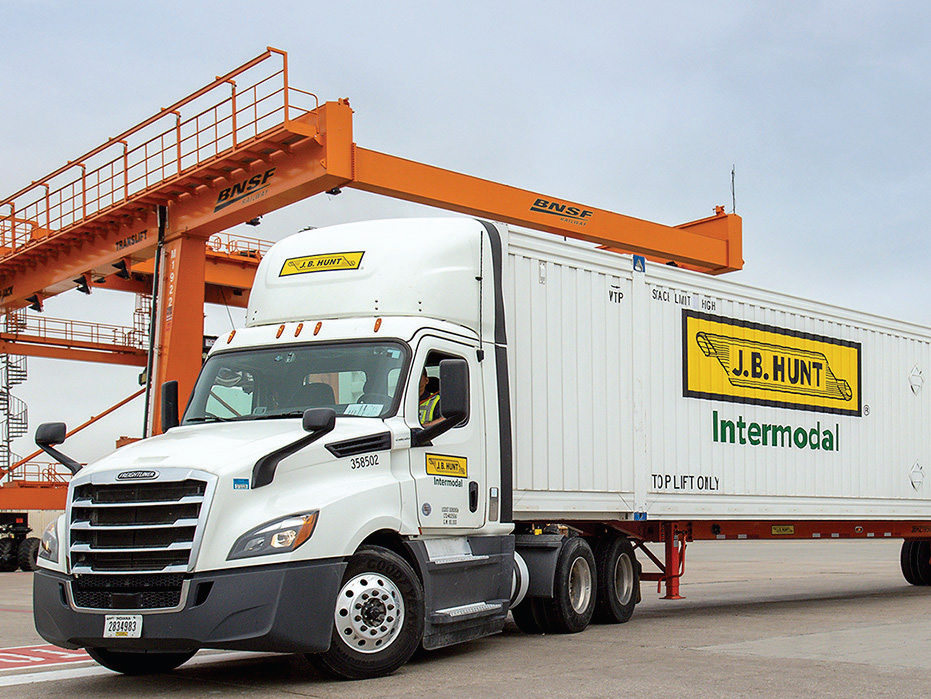Carrier is adding capacity in anticipation of freight rebound.

The first half of 2022 represented the peak of pandemic consumer demand, leading to spikes in international freight volumes, which, in turn, fed into a boom in the intermodal sector. Now that freight volumes are sinking—or approaching pre-pandemic normalization, as some would say—it’s not surprising that intermodal would suffer the same fate, even for an industry leader like J.B. Hunt, a trucking company whose name is synonymous with intermodal. But it’s important to keep in mind that year-over-year volumes, revenues, and income for the first half of this year will inevitably compare that much less favorably to the record-breaking 2022. J.B. Hunt’s intermodal segment accounted for 47% of total revenue and 60% of operating income last year.
Second quarter 2023 intermodal volume at J.B. Hunt decreased 7% compared to the same period in 2022, leading to a 19% drop in revenue and a 29% plummet in operating income for the quarter. At least from a numbers perspective, the second-quarter financial statistics were worse than J.B. Hunt’s intermodal performance numbers for the first quarter of 2023.
Besides the drop in the high-level intermodal numbers, the carrier also experienced a 13% decrease in gross revenue per load in the second quarter, lower rates, and higher driver and non-driver wages and benefits.
But J.B. Hunt with an anti-cyclical strategy, has also been adding capacity during this year’s downturn, acquiring 326 new pieces of trailing equipment during the second quarter, and over 1,000 during the first quarter, foreseeing a freight turnaround on the horizon.
Freight Recession and Intermodal
Intermodal’s poor performance during the first half of the year came on the heels of a freight downturn during the second half of last year, as consumers shifted their spending back towards services and importers were stuck with excess inventory. “The inventory destocking cycle” resulted in a “decline in import activity,” said Darren Field, executive vice president and president of intermodal at J.B. Hunt Transport Services. “While we are hesitant to suggest the presence of any green shoots, we saw evidence from customers in June that the destocking trend has moderated.”
A look at the numbers bears that out. While J.B. Hunt’s intermodal volumes in the second quarter declined 7%, they were down 9% in April, 8% in May, and 4% in June, suggesting an easing in the downward trajectory.
But Field doesn’t want to sound too optimistic. “Coming into the year, we relied heavily on customer forecasts, and they were largely all wrong,” he said, noting that many of them felt volume would return to West Coast ports, an intermodal stronghold once a labor deal was reached. “Today, we’re still a little cautious on what we expect as the year goes on. We’re still in a wait-and-see mode.”
J.B. Hunt is certainly not alone in experiencing an intermodal downturn, and, on the brighter side, is arguably outpacing the rest of the industry. Intermodal containers moving on the U.S. Class I railroads were down 9% in the first quarter of 2023 and were down 12% during the second quarter. Container imports decreased 20.0% in April, 20.1% in May, and 18.6% in June, at the nation’s top 10 ports, according to The McCown Report.
In contrast to some other carriers, J.B. Hunt has added capacity during this year’s freight downturn. That decision placed the company under additional financial stress, but, according to Field, in a good position to serve customers when a freight recovery comes to fruition.
“We’re carrying extra costs and we have extra equipment we’re not utilizing,” he said. “We took driver wages up a year ago. Those wages are certainly going to stay elevated and yet the market has challenged us with pricing and prices are negative.
“We have stressed the importance of sustaining service through a volume recovery, and that’s where our focus is today,” Field added. “We like our position and feel confident in our rail providers’ ability to handle more volume as a recovery develops.”
Anticipating a Turnabout
A turnaround in J.B. Hunt’s intermodal financial performance will be driven by increases in volumes, not prices, Field predicted. “Price will always improve our margin faster than volume will,” but volumes are more likely to increase faster than prices, he said. “I don’t anticipate any sort of pricing market in the near term that’s going to help with our margin as quickly as we might see an opportunity to grow our volume.”
The company’s decision to grow its container fleet by 150,000 over the next two to four years was made, according to Field, “with the mindset of growing our volume at a correct return, and that will continue to be our focus. We are in the best position to commit more intermodal capacity to our customers, which should present meaningful opportunities to unlock value in our network for the benefit of our stakeholders.”
For what it’s worth, Wall Street appears to concur with that assessment. During the week after the company reported its poor second-quarter results, which was worse than what the analysts were predicting, share prices increased by 5%, and then took off from there.
“J.B. Hunt had a rough quarter,” said one analyst report, “but the outlook for rebound is healthy. Business is down compared to last year but stabilizing well above the 2019 levels.”
The price of J.B. Hunt stock faltered immediately after the second-quarter results were announced, “but bulls bought the dip and drove it higher,” said the analyst report. Four analysts revised their price targets for the stock within a day after the second-quarter announcement, all of them higher. According to Marketbeat.com, “The consensus rating is a Moderate Buy which has held steady over the past year.”
The company is well positioned for “when business begins to pick up, which could come soon,” the analyst report concluded. “The odds of a recession in 2023 have been significantly reduced, which may lead to reinvigorated economic activity as the second half wears on.”




